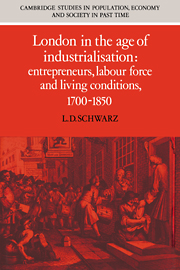Book contents
- Frontmatter
- Contents
- List of figures
- List of tables
- Acknowledgements
- List of abbreviations
- Introduction
- Part I Wealth and occupations in London
- 1 The structure of London's economy and labour force
- 2 Manufacturing, services and the London bourgeoisie
- Part II Fluctuations and mortality in the metropolis
- Part III The standard of living and the London trades
- Conclusion: downstream from industrialisation
- Appendices
- Bibliography
- Index
- Cambridge Studies in Population, Economy and Society in Past Time
1 - The structure of London's economy and labour force
Published online by Cambridge University Press: 11 September 2009
- Frontmatter
- Contents
- List of figures
- List of tables
- Acknowledgements
- List of abbreviations
- Introduction
- Part I Wealth and occupations in London
- 1 The structure of London's economy and labour force
- 2 Manufacturing, services and the London bourgeoisie
- Part II Fluctuations and mortality in the metropolis
- Part III The standard of living and the London trades
- Conclusion: downstream from industrialisation
- Appendices
- Bibliography
- Index
- Cambridge Studies in Population, Economy and Society in Past Time
Summary
Employment in 1851 and earlier: the overall picture
The 1851 census is a good stopping point for this study, providing as it does the best census available throughout the period studied. It is presented in figures 1.1, 1.2 and 1.3; the criteria for inclusion in the various categories are those of the Cambridge Group, as discussed in appendix one. The detailed figures are given in appendix three and appendix four.Some conclusions are striking. First of all, in 1851 the largest sector of employment was manufacturing, employing over 373,000 persons, thereby making London the largest manufacturing town in the country. Manufacturing occupied a third of the London labour force. Domestic service came next, with nearly a quarter, then dealing, with a ninth. Although manufacturing was by far the largest sector of employment, figure 1.2 shows that it was not manufacturing that made London unique. With 13.7 per cent of England and Wales' labour force, London had 13.6 per cent of those employed in manufacturing. Transport and dealing both occupied a proportion much higher than this – transport with 24.1 per cent of the national labour force so engaged, and dealing with 24.3 per cent – as did the smaller service sectors – government, other services and professions, and particularly banking and insurance with a figure of 41 per cent.
- Type
- Chapter
- Information
- London in the Age of IndustrialisationEntrepreneurs, Labour Force and Living Conditions, 1700–1850, pp. 11 - 30Publisher: Cambridge University PressPrint publication year: 1992

